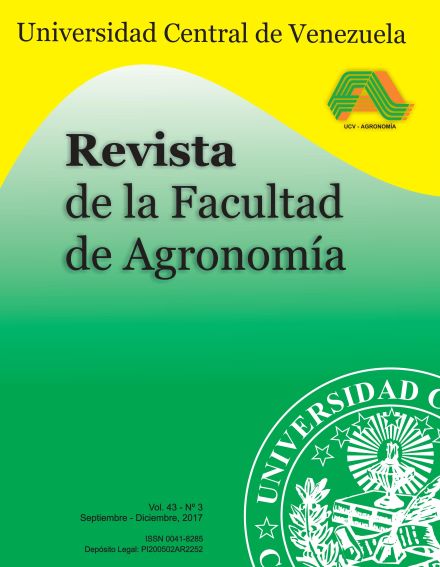Capacidad antagónica de aislamientos nativos y comerciales de Trichoderma spp. frente a Fusarium verticillioides y Aspergillus flavus aislados de maíz
Palabras clave:
control biológico, hongos antagónicos, hongos patógenos, biological control, antagonistic fungi, pathogenic fungi.Resumen
Para comparar la capacidad antagónica in vitro de 17 aislamientos de Trichoderma,13 nativos (AN) (T1, T1.1, T1.2, T2.1, T2.4, T3, T4.2, T4.3, T6.2, T9.1, T16.1, Tva, Tvc) y 4 comerciales (AC) {A (T. viride), B (T. lignorum), C (T. harzianum), D (T. harzianum)} frente a Fusarium verticillioides (Fv) y Aspergillus flavus (Af), se utilizó el método de cultivo dual en PDA, y se midió dicha capacidad, mediante las variables de porcentaje de inhibición del crecimiento micelial (PIC) y de esporulación (PIE). Se evaluaron 34 pruebas de enfrentamiento con su testigo (sólo Fv o Af), bajo un Diseño Completamente Aleatorizado, con 5 repeticiones/tratamiento y mediante la prueba de Tukey (α=0,05). Se identificaron a nivel de especie los 4 aislamientos de Trichoderma que resultaron destacados, sobre la base de sus características macroscópicas, microscópicas y comparación con claves micológicas. Los resultados indicaron diferencias entre los aislamientos de Trichoderma en las variables medidas, para ambos patógenos en estudio (Fv y Af). En las interacciones entre Fv y AN de Trichoderma, los PIC variaron desde 2,18% hasta 43,33%, mientras que los PIE desde 10,89% hasta 92,74%, destacando Tva, Tvc, T2.1 y T2.4. Dentro de los AC sobresalieron T. viride (PIC: 44,4% y PIE: 93,78%), y T. harzianum (D) (PIC: 12,5% y PIE: 90,24%). En los enfrentamientos Af vs AN, el PIC varió entre 22,4 y 55,1%, siendo los mejores T9.1 y T4.3 con 55,15 y 53,1%, respectivamente. Dentro de los AC, se halló que el PIC estuvo entre 36,70% {T. harzianum (D)} hasta 47,55% (T. lignorum). Se concluye que los aislamientos promisorios de Trichoderma frente a los patógenos en estudio fueron Tva (T. aureoviride) y Tvc (T. viride) sobre Fv y T9.1 (T. harzianum) y T4.3 (T. atroviride) en Af, los cuales pudieran ser ensayados solos o combinados en diferentes condiciones (in vitro, umbráculo y campo).
Antagonistic capacity of native and commercial isolates of trichoderma spp. against fusarium verticillioides and aspergillus flavus isolated from corn
ABSTRACT
To compare the in vitro antagonistic capacity of 17 Trichoderma isolates, 13 native isolates (AN) (T1, T1.1, T1.2, T2.1, T2.4, T3, T4.2, T4.3, T6.2 , T9.1, T16.1, Tva, Tvc) and 4 commercial isolates (AC) {A (T. viride), B (T. lignorum), C (T. harzianum), D (T. harzianum)} versus F. verticillioides (Fv) and A. flavus (Af) the method of dual cultures in PDA was used and this capacity was measured using variables mycelial growth inhibition (PIC) and sporulation (PIE). The evaluation consists of 34 confrontation tests with their control (only Fv or Af) under a Completely Randomized Design with 5 repetitions / treatment and by Tukey test (α = 0.05). The 4 isolates of Trichoderma that were highlighted were identified at the species level, based on their macroscopic, microscopic
characteristics and comparison with mycological clues. The results indicated differences between the isolates of Trichoderma in the measured variables, for both pathogens under study (Fv and Af). In the interactions between Fv and AN of Trichoderma, the CIP varied from 2.18% to 43.33%, while the PIE from 10.89% to 92.74%, distinguish Tva, Tvc, T2.1 and T2.4. Within CA, T. viride (PIC: 44.4% and PIE: 93.78%), and T. harzianum (D) (PIC: 12.5% and PIE: 90.24%) stood out. In the Af vs. AN clashes, the PIC varied between 22.4 and 55.1%, with the best T9.1 and T4.3 with 55.15 and 53.1%, respectively. Within the CA, it was found that the PIC was between 36.70% {T. harzianum (D)} up to 47.55% (T. lignorum). It is concluded that the promising isolates of Trichoderma against the pathogens under study were Tva (T. aureoviride) and Tvc (T. viride) on Fv and T9.1 (T.harzianum) and T4.3 (T. atroviride) on Af, which could be tested alone or combined in different conditions (in vitro, umbraculum and field) conditions.





